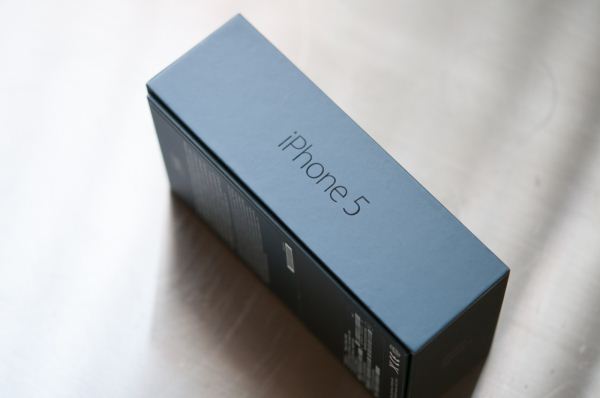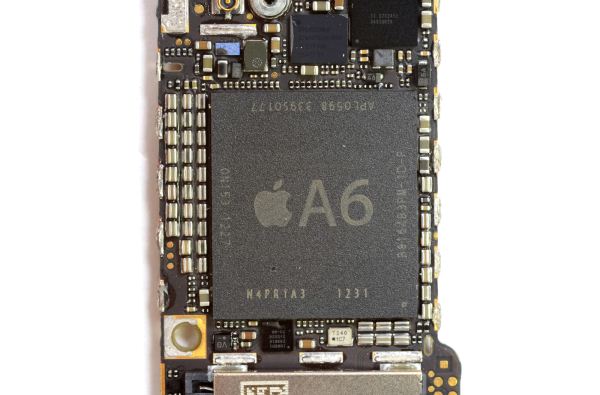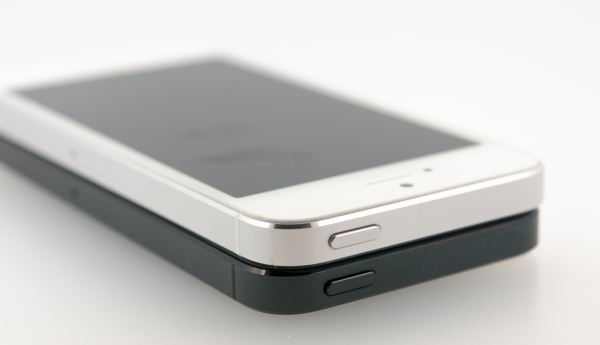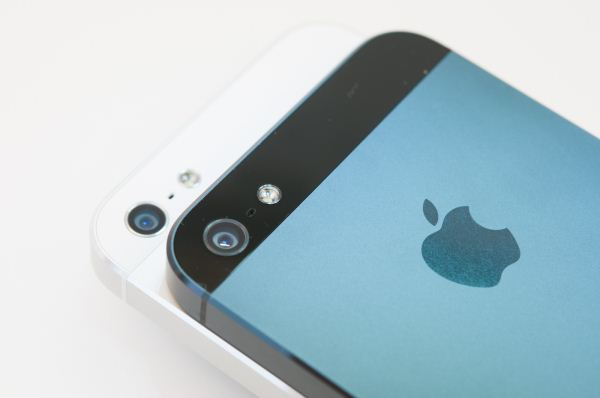The iPhone 5 Review
by Anand Lal Shimpi, Brian Klug & Vivek Gowri on October 16, 2012 11:33 AM EST- Posted in
- Smartphones
- Apple
- Mobile
- iPhone 5
Final Words
With a device vendor that also happens to moonlight as an SoC vendor and software developer we really need three parts to this conclusion. I’ll begin with the silicon, as that’s ultimately what enables the overall experience.
A6 SoC Conclusions
With the iPhone 4S Apple made a conscious decision to shift its annual smartphone release to the latter half of the year. At the same time, Qualcomm’s 28nm schedule put its new SoCs in phones at the earlier part of the year. All indications point to the first Cortex A15 based designs showing up similarly in the first half of 2013. All of this conspires to set the market up for some very interesting leap frogging. Without a major delay that impacts either Apple or its Android competitors, it looks like in the Spring we’ll see Android devices leapfrogging the iPhone and Apple responding in kind in the fall. The staggered release cadence won’t continue forever, but at least for the next generation it appears that will be how it plays out.
I don’t know which refresh cycle makes the most sense (new architectures earlier in the year vs. later) from a business standpoint. I suspect there’s something to be said about hitting the holiday buying season but I’m not much of a financial analyst.
Apple’s decision to introduce a custom ARM core in the A6 SoC is very unique. I would normally have expected Apple to go for a Cortex A15 based design in the next round however I’m no longer sure. Investing in your own CPU design isn’t usually something you do once and then just drop the next generation. I would assume Apple has plans to continue to evolve this architecture in a very power focused way. We’ve mentioned time and time again that ARM’s Cortex A15 was first conceived as an architecture for more power hungry systems (servers and other PC competitors). The Cortex A15 moved down the totem pole and will likely rely on smaller cores to keep power consumption in check when running lighter workloads. It wouldn’t be a stretch to envision a slightly larger (~20%?) Swift core next generation built at Samsung or TSMC, adding some architectural features to drive performance up.
Swift appears to offer better power/performance efficiency than any other currently available ARM architecture. Its architecture, performance and power profile most closely resemble Qualcomm’s 28nm Krait/Snapdragon S4, although through hardware or software optimizations it appears to be able to come out slightly ahead. Apple complicates the gains in performance by increasing clock speed dramatically over the iPhone 4S, which makes the architecture look more revolutionary than evolutionary in nature. A good part of the 2x increase in CPU performance compared to the iPhone 4S boils down to clock speed, however there are significant improvements to the memory subsystem that really help things. ARM’s Cortex A15 will likely pull ahead of Swift in CPU performance, although it remains to be seen how it will compare in power and what Apple will respond with in late 2013.
Intel’s Atom core remains very competitive with the best of the ARM world. A single core Atom still ends up being the only CPU that can regularly outperform Apple’s Swift, however it does so while seemingly consuming more power. Whether the performance advantage can make up for the peak power deficit remains to be seen as we lack a good, high-end Atom based LTE smartphone to really test that theory against.
On the GPU side Apple continues to be at the forefront of innovation, however Qualcomm appears to have learned quickly as the Adreno 320 manages to give the PowerVR SGX 543MP3 a run for its money. I suspect next year we’ll see similarly competitive performance from Intel and NVIDIA as well (finally!). Having an aggressive player in the silicon space always makes for good competition once everyone adjusts their release cadence.
Overall the silicon story in the iPhone 5 is a very good one. Performance increases by the biggest margin since the move from the iPhone 3G to 3GS. If you are the type of user who can appreciate improved response time, the iPhone 5 definitely delivers.
The market is becoming increasingly competitive however. Just as Google responded aggressively to close the UI performance gap between Android and iOS, the SoC vendors appear to be doing the same with their silicon. Going forward it is going to become more difficult to maintain significant performance advantages similar to those Apple has enjoyed in previous generations. It’s really going to boil down to software and ecosystem in the not too distant future.
iPhone 5 Device Conclusions
As a device, the iPhone 5 is a solid evolution of its predecessors. The larger 4-inch screen doesn’t fundamentally change the device, but it definitely modernizes it. Going back to the old 3:2 aspect ratio iPhones feels extremely claustrophobic now. After using the iPhone 5 for weeks, picking up an older iPhone feels a lot like switching between the iPhone 4 and iPhone 3G did.
The new device feels appreciably thinner and lighter, although a tradeoff is the delicate feel of the anodized aluminum on the 5. Although you’d normally assume moving away from glass would make the device feel more rugged, the fear of scratching the very thin anodized coating quickly supplants any relief you might have had. The iPhone 5 lacks the heft that gave the 4/4S that jewel-like feel, but it does so without feeling overly cheap and ends up being an improvement in overall portability. Design is subjective, but I do believe that Apple has managed to move forward in this regard as well.
The iPhone 5 marks Apple’s first integration of LTE into a smartphone, and the process went relatively smoothly. Handovers between 3G and LTE are relatively seamless, although we did notice the occasional dropped hotspot connection when calls came in while we were tethered over WiFi and on LTE. For those of you who haven't yet enjoyed the world of LTE on a smartphone, LTE support delivers one of the bigger performance improvements you’ll see with the iPhone 5.
At a high level, the iPhone 5’s cameras appeared to be some of the least unchanged elements of the new device however in practice the improvements are significant. The front facing camera now delivers much higher quality photos and the rear facing camera's low light performance is a major step forward compared to the iPhone 4S. Given the amount of smartphone photography that happens in poorly lit conditions, I suspect the improvements Apple made to the 5's rear facing camera will be quite noticeable in regular use.
Although the bulk of the discussion on display had to do with its taller aspect ratio and mildly increased resolution, it's really the move to in-cell touch (reducing reflections/glare) and the increase in quality that are most revolutionary here. The iPhone 5's display now offers full sRGB coverage and much better accuracy than its predecessor. Although a subtle improvement in day to day use, it's good to see Apple continuing to push the envelope here.
Battery life, as we mentioned earlier, is really a mixed bag. Depending on your workload you'll either see improved battery life due to the faster platform and a quick rush to sleep or you'll see a regression if you put the new silicon to heavier use as a result of its speed. The days of relatively static battery life progressions are behind us at this point, welcome to the world of increased dynamic range of power consumption. It's a tradeoff that has to be made in pursuit of ever increasing performance unfortunately. Apple seems to maintain good idle power characteristics in light of everything.
The big question is of course whether or not you should upgrade to the iPhone 5. The move to LTE alone is a big enough reason to upgrade for any heavy user of mobile data. The larger/improved display, much faster SoC and 5GHz WiFi support are all icing on the cake - and this is one well iced cake. If you have a subsidized upgrade available via your carrier, I'd say the upgrade is a no brainer. If however you've got to pay full price you have to take into consideration what's coming on the horizon. A faster version will likely hit in late 2013, and we'll potentially see a move to 20nm silicon in late 2014 (paving the way for an improvement in power profile). If you're on a 2 year upgrade cycle, buying the 5 now and upgrading again in 2014 wouldn't be a bad idea.
iOS 6 Conclusions
Finally, we have to conclude our look at the iPhone 5 with a discussion of its operating system. As I’ve mentioned in articles/videos past, Apple and Microsoft find themselves in somewhat similar positions when it comes to the role their smartphones play in the market. Both companies run quite profitable businesses selling Macs and PCs respectively, and as a result their smartphones can act as companion devices rather than primary computing devices. Unless there’s a dramatic change in Chrome OS, Google has to rely on Android smartphones and tablets to get their share of computing dollars (and search results). Apple and Microsoft differ a bit when it comes to tablets as Apple uses the iPad to compete with low-cost PCs.
I believe understanding the motives helps explain the software decisions that are made. As the iPad has to serve as a cheap PC alternative, iOS ends up inheriting some productivity focused enhancements - just not as many as a full blown OS would.
As it applies to the iPhone, iOS serves as a companion platform, a true pocket digital assistant. Its goal is to be an appliance, not a full blown computing device, and as such it looks and feels very different than Android.
With the latest update to iOS, Apple continues to evolve the platform. Similar to the iterative improvement in iPhone hardware, Apple’s yearly iOS cadence is largely responsible for its solid footing in the market. Although a clear regression in iOS Maps quality plagued this latest update, the platform is still a good one for those who it resonates with.
iOS remains very appliance-like in its behavior. Despite the added complexity that iOS has inherited over the years, Apple has been able to retain much of the simplicity that drew users to the platform in the early days. The iPhone/iOS platform is unique in that, unlike OS X, it started as a mainstream platform rather than a computing platform that had to try and become more consumer friendly over time.
If you’re after something fundamentally different, you’ll have to look elsewhere as I don’t believe iOS is destined for a dramatic departure from the current model anytime soon. Thankfully there are good alternatives from both Google and Microsoft if iOS isn’t what you’re looking for. Pressure from Apple on both the hardware and software side will help ensure that those platforms continue to progress as well - competition is alive and well in the mobile industry, that’s for sure.
For existing iOS fans and/or iPhone users, the latest iteration of iOS on the iPhone 5 (perhaps with the exception of Maps) does nothing to alienate you. Apple has done a good job of dutifully maintaining the platform and remaining true to its roots. As a significant source of Apple’s revenue, you would expect no less.















276 Comments
View All Comments
medi01 - Wednesday, October 17, 2012 - link
1) Compare ipad2's gamut, cough2) Check values on toms
http://media.bestofmicro.com/3/4/331888/original/g...
http://www.tomshardware.com/reviews/ipad-3-benchma...
Unlike anand, toms was beyond primitive contrast/brightness benchmarking for quite a while.
thunng8 - Thursday, October 18, 2012 - link
Not sure if I should trust Tom's figures compared to Anands's.In any case, both show the ipad3 has higher gamut, especially in sRGB.
steven75 - Wednesday, October 17, 2012 - link
I think what you meant to say is that AMOLEDs win on black levels and that's about it. LCDs still win in accuracy and most importantly ability to see them in outdoor settings.KoolAidMan1 - Tuesday, October 16, 2012 - link
Not even close. Even the better Android displays like the Galaxy S3 has a PenTile display. Despite having more "pixels" it actually has fewer subpixels than the iPhone does. Unless you have bad eyesight the S3 display looks really bad in comparison, and this is before we get to even worse smartphone displays out there by HTC, etc.Sufo - Tuesday, October 16, 2012 - link
Old pentile displays were visibly jaggy on vertical lines - even my old lumia 800 exhibited this to some extent. On the GS3 tho, it is not noticeable and it has nothing to do with eyesight.Your comment makes it sound (to someone who has seen many different smartphone displays in person) as though you haven't spent much time with the GS3 (read: many smartphones) at all. Simply mentioning that is uses pentile subpix config, from you, sounds like regurgitated information. Not only that, but you seem to gloss over the many benefits that amoled panels bring. It's arguable that these benefits are more important than an accurate colourspace on (specifically) a mobile phone - although it is ofc entirely subjective.
This brings me to the last tell of ignorance I noted; your mention of HTC. Have you used a One X? For those who do not like amoled panels, the display on the one x is perhaps nicer than both the gs3 and the ip5. Ofc you may say Android is not your cup of tea, and that's a perfectly justifiable stance, however it has nothing to do with display tech.
tl;dr You sound like you don't know what you're talking about
KoolAidMan1 - Tuesday, October 16, 2012 - link
I do know what I'm talking about given that I've seen many smartphones, and I've calibrated my share of desktop displays to sRGB.Differences in display tech aside, Android phones have never gotten color profiles right, EVER. They're almost always oversaturated, have too much contrast, and are inaccurate. Anand even posted a difference in color accuracy between several devices, and the profile for the S3 is totally what I expected.
The S3 really doesn't look good, period, but then again there are people who argue that TN panels are just fine against IPS. I'm used to hearing nonsense on forums when it comes to display from people who don't know what to look for.
KoolAidMan1 - Tuesday, October 16, 2012 - link
BTW, apologies if that came out harsh, but the difference in color and contrast accuracy between something like the S3 and a properly calibrated device is a night and day difference to me. I'm pretty sensitive to display quality though; my main desktop display at home is still an NEC and my plasma is a Pioneer Elite (RIP)rocketbuddha - Tuesday, October 16, 2012 - link
For Android you have the following 720p HD DisplaysSLCD - HTC Rezound (2011 tech)
SLCD 2 - HTC One X, Sony HD
HD SAMOLED Pentile - GS3, Galaxy Nexus, Moto Razr HD
HD SAMOLED RGB - Galaxy Note II
True IPS LCD - LG Optimus 4X, Optimus G
Super IPS LCD -Asus Padphone, Sharp phones etc
So you have big set of choices. If dark contrasts are important then SAMOLED is the way to go. SAMOLED RGB over SAMOLED Pentile.
If overall color and whites are important go with SLCD2.
IPS LCDs are the closest to the Retina Display and u have a choices there too. You can pick and choose what is good for you and have alternatives.
Spunjji - Thursday, October 18, 2012 - link
The HTC One X has what is hailed to be one of the best LCD smartphone displays out there. Your claim is invalid.Similarly, the Galaxy Note 2 has an AMOLED display without PenTile. Sure, it's lower density, but one does not hold a 5.5" screen so close to one's face.
medi01 - Wednesday, October 17, 2012 - link
""The iPhone 5 display is better than any current Android display.""Why don't you go hit your dumb head with something heavy, ipad would do?